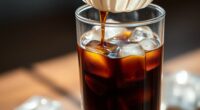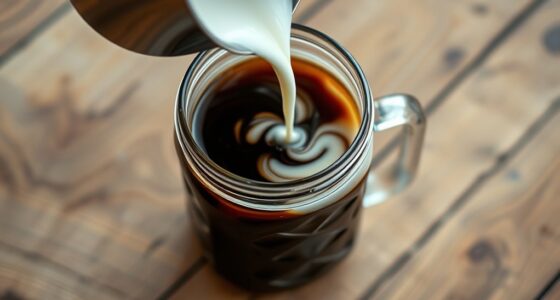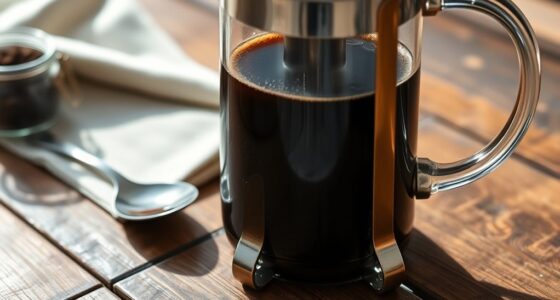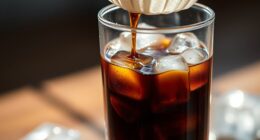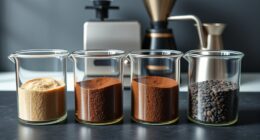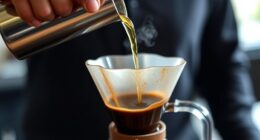To achieve the perfect coffee-to-water ratio, start with 1 to 2 tablespoons of coffee per 6 ounces of water, adjusting to your taste preferences. Use a kitchen scale for precise measurement rather than just scoops. Pay attention to the grind size, water quality, and temperature, as all these factors influence flavor. Mastering this balance guarantees consistent, flavorful brews; continue exploring to discover how to refine your method even further.
Key Takeaways
- Use 1 to 2 tablespoons of coffee per 6 ounces of water as a starting point.
- Adjust coffee amount based on desired strength and flavor preferences.
- For precision, measure coffee with a kitchen scale instead of volume.
- Consider the brewing method; different devices may require specific ratios.
- Maintain consistency by using the same ratio each time to achieve reliable taste.
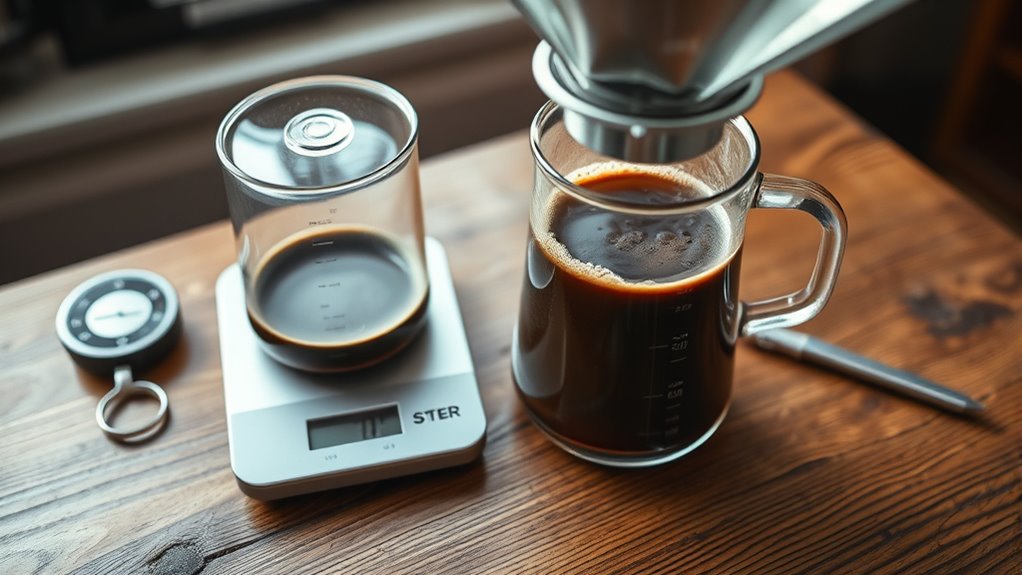
Getting the perfect cup of coffee starts with the right coffee-to-water ratio. This balance is vital because it influences the strength, flavor, and overall quality of your brew. But there’s more to it than simply measuring. You need to pay attention to the details, like choosing the right coffee grind and maintaining the proper brewing temperature. These factors help extract the best flavors from your coffee and guarantee consistency every time you brew. Additionally, understanding best brewing practices can significantly enhance your coffee experience by ensuring optimal extraction and flavor development. Your choice of coffee grind plays an indispensable role in how well your coffee turns out. For example, a coarse grind works best for French press brewing, while a medium grind suits drip machines, and a fine grind is ideal for espresso. Using the wrong grind can lead to over-extraction or under-extraction, resulting in bitter or weak coffee. When you’re measuring your coffee, consider the grind size, as it directly affects how quickly water interacts with the grounds and how the flavors develop during brewing. To achieve consistent results, many baristas also pay attention to water quality, since mineral content and purity can impact extraction and flavor. Brewing temperature is another key element in achieving the perfect cup. Ideally, water should be heated to around 195°F to 205°F (90°C to 96°C). Too hot, and you risk burning the coffee, leading to a bitter taste. Too cold, and the extraction will be incomplete, resulting in a weak or sour flavor. Maintaining this ideal temperature range ensures that your coffee’s aroma and taste are fully developed, providing a balanced and rich flavor profile. To measure your coffee-to-water ratio correctly, start by determining how much coffee you want to brew. A common ratio is 1 to 2 tablespoons of coffee per 6 ounces of water, but this can vary based on personal preference. Use a kitchen scale for precision, weighing the coffee instead of relying solely on volume measurements. This guarantees consistency, especially if you’re experimenting to find your ideal strength. Once you have the right amount of coffee, adjust the brewing temperature if you’re using a manual method, and select the appropriate grind size for your brewing device.
Frequently Asked Questions
How Does Altitude Affect the Coffee-To-Water Ratio?
Altitude effects your coffee brewing, so you might need to make brewing adjustments. Higher altitudes often mean water boils at lower temperatures, which can impact extraction. To maintain your desired strength and flavor, you may need to increase the coffee-to-water ratio slightly or adjust brewing time. By understanding altitude effects, you guarantee your coffee remains balanced and flavorful, regardless of where you’re brewing.
What Are the Best Ratios for Cold Brew?
For cold brew, you should aim for a ratio of about 1:4 to 1:8, depending on your preferred strength. Use coarse-ground coffee and consider your coffee bean varieties, as some are more robust than others. Keep the brewing temperature low, around room temperature or colder, and steep for 12-24 hours. Adjust the ratio to find your perfect balance, whether you like it stronger or more diluted.
Does Grind Size Influence the Ideal Ratio?
Yes, grind size influences the ideal ratio because it affects grind uniformity and brew consistency. A finer grind increases extraction, so you might need to adjust the water amount to prevent over-extraction, while a coarser grind requires more water for balanced flavor. By ensuring your grind is uniform, you help maintain a consistent brew, making it easier to find the perfect ratio that suits your taste preferences.
How Do Personal Preferences Alter the Ratio?
You can alter the coffee-to-water ratio based on your flavor preferences to enhance flavor customization. If you prefer a stronger, bolder taste, increase the coffee amount; for a lighter brew, use less. Adjusting the ratio also helps maintain brewing consistency tailored to your taste. Experiment with small changes until you find what best suits your palate, ensuring each cup meets your personal flavor preferences.
Can Adjusting the Ratio Improve Weaker Coffee?
If your coffee tastes weak, adjusting the ratio can definitely help improve brewing consistency and flavor balance. You might try increasing the coffee amount relative to water, which enhances strength without sacrificing clarity. Experiment with small changes until you find the right balance that suits your taste. This way, you guarantee each cup has a richer flavor, better highlighting the coffee’s natural qualities and making your brewing more consistent.
Conclusion
Mastering the perfect coffee-to-water ratio transforms your brew into a symphony of flavor, turning each cup into a masterpiece. When you measure with precision, you reveal a world of rich aromas and bold tastes that can rival the most legendary cafés. Don’t settle for bland or bitter—your perfect cup is waiting to be discovered. So, get your scales ready and brew with confidence—because once you find that ideal ratio, you’ll never want to drink anything less than perfection again.

